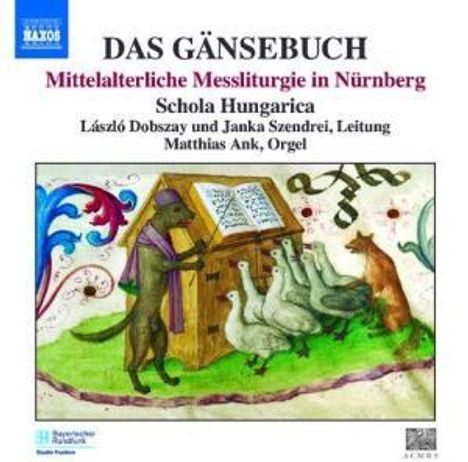Das Gänsebuch - Mittelalterliche Gesänge aus Deutschland auf CD
Das Gänsebuch - Mittelalterliche Gesänge aus Deutschland
Herkömmliche CD, die mit allen CD-Playern und Computerlaufwerken, aber auch mit den meisten SACD- oder Multiplayern abspielbar ist.
Lassen Sie sich über unseren eCourier benachrichtigen, falls das Produkt bestellt werden kann.
Bicinium & Choral; Messe zu Himmelfahrt; Messe für die Heilige Lanze & Nägel; Messen für St. Deocarus, St. Sebaldus, St. Monika, St. Martha, St. Lorenz; Fantasia in C; Carmen in G; Lied "Ewiger Gott";Ricercar in d; Kyrie Angelicum; Maria zart, von edler Art; Ich werde erlöst; Glocken der Kirche von St. Lorenz
- Künstler:
- Matthias Ank (Orgel),Schola Hungarica, Dobszay, Szendrei
- Label:
- Naxos
- Aufnahmejahr ca.:
- 2002/2003
- UPC/EAN:
- 0747313241224
- Erscheinungstermin:
- 1.7.2005
Ähnliche Artikel
Der volkstümliche Name Gänsebuch leitet sich von einer basde-seitigen Illumination zum Fest der Himmelfahrt ab, die einen Chor von Gänsen zeigt, der von einem als Kantor verkleideten Wolf geleitet wird. Vor den Gänsen steht ein offenes großformatiges Musikmanuskript auf einem Ständer. Ein Fuchs schlängelt sich hinter die Gänse, seine Pose deutet an, dass er sich einen der Sänger schnappen will.
Das Gänsebuch mit insgesamt 1120 Seiten ist die einzige vollständig erhaltene Quelle für die vorreformatorische Liturgie der Messe in Nürnberg und bewahrt die Musik einer der bedeutendsten Stadtpfarrkirchen des Reiches. Die Nürnberger Manuskript-Illumination erreichte im Gänsebuch einen Höhepunkt. Das Manuskript befindet sich heute in der Pierpont Morgan Library in New York und trägt die Signatur M. 905.
Da der Umfang der im Gänsebuch enthaltenen Musik so beträchtlich ist, ist der Anteil, der für diese Compact Disc aufgenommen wurde, recht winzig. Ausgewählt wurden Gesänge von Festen mit besonderer Relevanz für die Kirche St. Lorenz und Nürnberg. In den meisten Fällen handelt es sich um Ersteinspielungen. Viele Quellen dokumentieren den Einsatz der Orgel in der Liturgie von St. Lorenz. Die berühmte Schwalbennestorgel an der Nordwand des Kirchenschiffs wurde 1444 aufgestellt und 1479 erweitert. Es wurde daher beschlossen, die Orgelmusik mit den Messgesängen abzuwechseln.
Product Information
The popular name Geese Book derives from a basde- page illumination for the Feast of the Ascension showing a choir of geese directed by a wolf dressed as cantor. In front of the geese is an open large-size musical manuscript on a stand. A fox slinks behind the geese, his pose implying that he is about to grab one of the singers.
The Geese Book with a total of 1120 pages is the only complete extant source for the pre-Reformation liturgy of the Mass in Nuremberg and preserves the music of one of the most prominent city parish churches of the empire. Nuremberg manuscript illumination reached a high point in the Geese Book. The manuscript is today preserved in the Pierpont Morgan Library in New York, bearing the shelf number M. 905.
Because the volume of music contained in the Geese Book is so substantial, the portion that was recorded for this compact disc is quite minuscule. Chants from feasts with a special relevance for the church of St Lorenz and Nuremberg were chosen. In most cases these are première recordings. Many sources document the use of the organ in the liturgy of St Lorenz. The famous swallow’s nest organ on the north wall of the nave was installed in 1444 and enlarged in 1479. It was therefore decided to alternate organ music with the Mass chants.
Rezensionen
FonoForum 11/05: "In den sehr gerade und schlank geführten Stimmen der Schola Hungarica haben die kunstvollen Gesänge ihre idealen Interpreten gefunden."Disk 1 von 1 (CD)
-
1 Komm, Heiliger Geist (Bicinium und Choral)
Mass for Ascension (Messe) (Auszug)
-
2 Introitus: Viri Galilei
-
3 Hans Kotter: Fantasia C-Dur
Mass for the Holy Lance and the Nails (Messe)
-
4 Introitus: Foderunt manus meas - Alleluia: Michael descendit - Alleluia: Surrexit pastor bonus - Sequentia
-
5 Conrad Brumann: Carmen G-Dur
Mass for Saind Deocarus (Messe) (Auszug)
-
6 Alleluia: Justus germinabit - Sequentia: Dilectus deo et hominibus
-
7 Ludwig Senfl: Ewiger Gott
Mass for Saint Sebaldus (Messe) (Auszug)
-
8 Introitus: Os justi meditabitur - Graduale: Os justi meditabitur - Alleluia: O Sebalde - Sequentia: Concinamus pariter
-
9 Heinrich Isaac: Riccercare d-moll
Mass for Saint Monica (Messe) (Auszug)
-
10 Offertorium: Jesu transfixi vulnera
-
11 Conrad Paumann: Kyrie Angelicum
Mass for Saint Martha (Messe)
-
12 Introitus: Marhae piae memoriam agamus - Graduale: Domine, nos est tibi cure - Alleluia: Ora pro nobis - Sequentia
-
13 Arnolt Schlick: Maria zart, von edler Art
Mass for Saint Lawrence (Messe) (Auszug)
-
14 Introitus: Confessio et pulchritudo in conspectu eius
-
15 Heinrich Finck: Ich wird erlost
-
16 Bells of the Church of St. Lorenz






